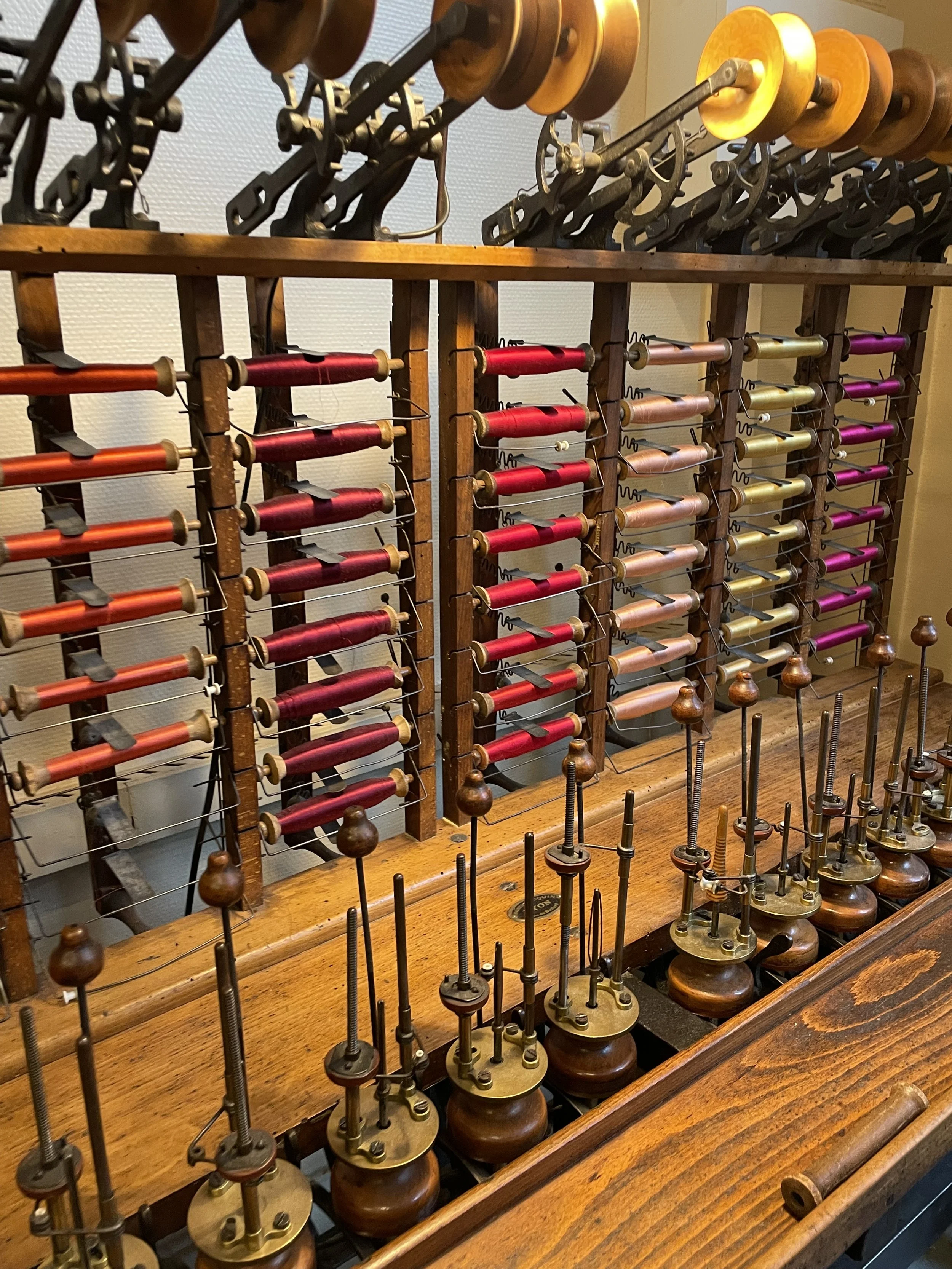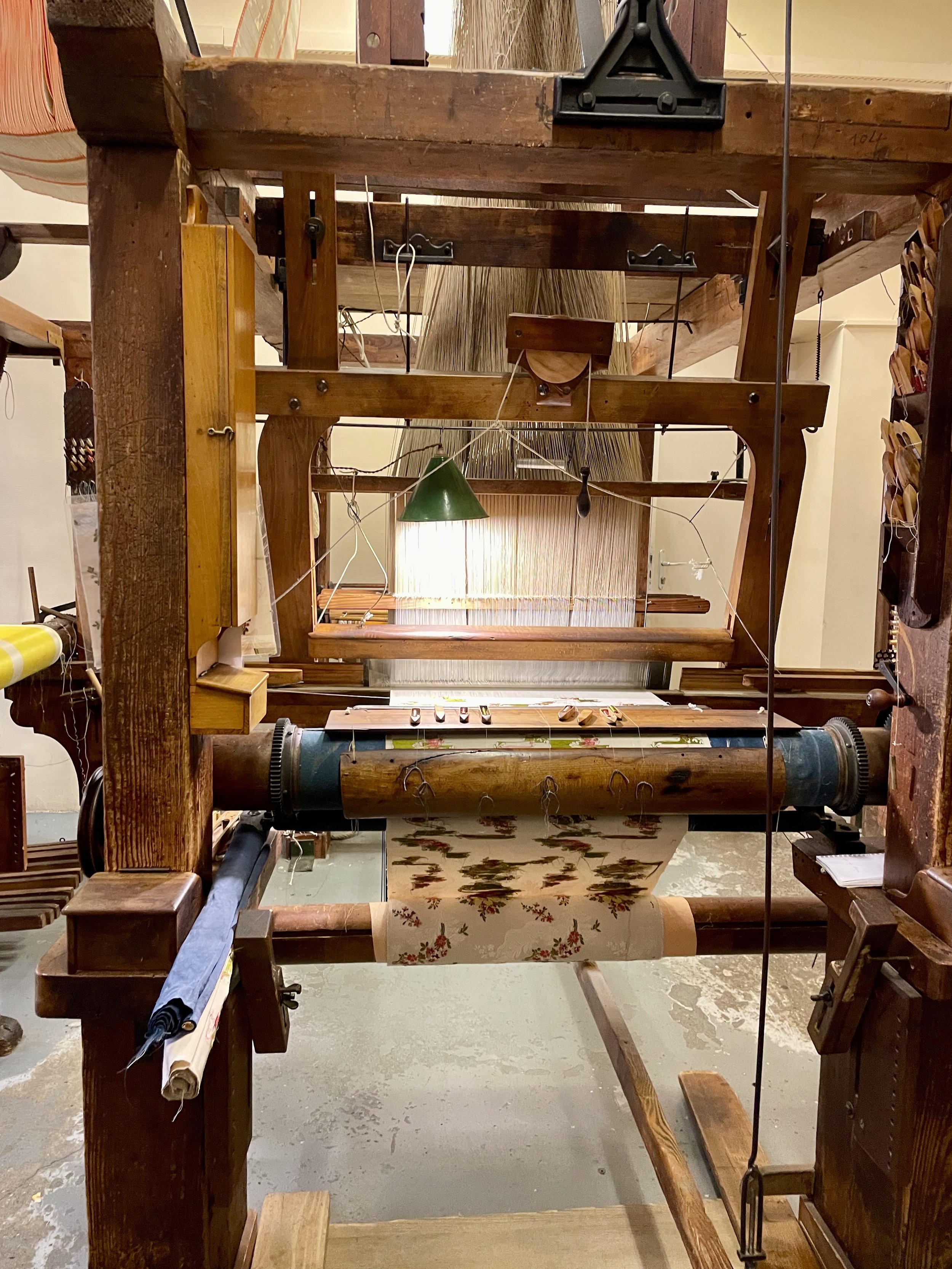La Plus Belle Soie: The Enduring Influence of Silk Weavers in Lyon
*Article from Lexington Line Spring/Summer 2023 Issue, page 15
Check out the full issue here
All photos are the author’s own.
I followed the narrow cobblestone streets of Lyon, France’s Croix-Rousse neighborhood, which led the way to what used to be the silk weaving district. The compact buildings evinced early 1900s architecture, and the large windows accentuated the absence of the tall looms that used to stand behind them.
Turning down alleys and discrete deliverer passageways, I found the door to Mattelon’s Workshop, one of the last remaining silk workshops in Lyon. The loom’s rhythms echoed down the two-story walk-up, with blank plaster and wood beam detailed walls almost whispering the stories of the previous and current weavers—Georges Mattelon and his son, Jacques.
One of the many historical looms on display at the local museum.
These days, Mattelon’s Workshop serves as an example of what the silk industry used to be. With the expansion of mechanical looms, the decline of traditional artisanship began in the early 20th century––stripping weavers of their art of generational heritage.
“There’s the loss of passing down the tradition,” says Professor Hilda Alfonso, who teaches textiles at LIM College and has worked for both E.S. Sutton Inc. and Bentex Group. “So [weavers] lost a form of creativity.”
Lyon first became associated with silk weaving in the 15th century, when Italians settled in Croix-Rousse and new inventions were created that could produce highly intricate patterns only found in Lyon. The Croix-Rousse district was nicknamed “the hill that works” due to its many busy silk weavers, or what the French call “Canuts.”
The city gained popularity from other industries and a growing population. Weavers were also given patterns from artists and fashion designers to create beautiful silk textiles to supply the new mass market and industry demand, including the demand of France’s Emperor, Napoleon Bonaparte.
The French Revolution halted all industry work in 1789, however, and skilled laborers disappeared to protect their patterns and textiles, fearing that they would be burned or guillotined.
One of the many restored looms at the local museum.
Lyon’s silk industry revived itself in 1801 when the Jacquard loom gave the weavers a sense of familiarity, and only after its creation did the Canuts call this neighborhood home. The new technology set a precedent for weaving because it only required one weaver instead of the traditional three and helped quicken the process.
During the 19th century, the streets are said to have hummed with the continuous vibrations of the looms. The architecture of this area attests to the labor of the Canuts, with each building exhibiting high ceilings and dozens of windows to let in natural light so that they could work long hours.
The rising Industrial Revolution enabled Lyon to earn its claim to fame because all silk entering France made its first stop in the city. Canuts mastered the art of weaving on mechanical looms. Yet, as the years progressed and technology expanded, mechanical looms no longer needed weavers, and Canuts became sparse. The new technology increased efficiency and caused a decline in traditional weavers, who simply could not keep up.
“Weaving employed a great deal of people, and it changed this part of the world,” says Professor Alfonso. “There was a loss of that kind of skilled labor and workforce. The powered loom could do so much more and faster.”
Weavers moved on to use their skills for historical textile preservation and other fabric specialties, and silk weaving in Lyon was left to mass-produced mechanical looms.
La Manufacture Prelle is the last silk company preserving and recreating textiles by weaving them by hand for museum or castle clientele internationally. Their New York Showroom’s Manager, Diego Castro, claims that Prelle is the only company able to replicate original patterns from their archives.
“It’s how we keep our history alive,” he says. “Our treasures. It’s how we know previous orders and how we recreate past patterns and colorations. It tells us our history.”
Prelle has continued its heritage for five generations by expanding to couture designers and historical replications, but it is one of the few companies able to survive the decline of traditional Canuts.
From left: A back alley in Croix-Rousse with a preserved deliverer passageway; An older loom in Mattelon’s workshop no longer in use; One of the many looms inside Mattelon’s workshop showcasing a current project.
The stories of the original weavers also live on through Jacques Mattelon. He continues his father’s legacy and has rehabilitated the last silk workshop in Lyon. When I toured it, he shared the heritage of the Canuts and expressed his passion for the textile. He also shared his knowledge of each loom—demonstrating his use of them from his years weaving simple textiles for the local museum.
After moving to the Croix-Rousse neighborhood of Lyon in the late 1920s, Georges Mattelon put all of his time and effort into studying the art of silk weaving and worked tiring hours, sending his shuttle back and forth to create only mere centimeters of the woven fabric. But it did not discourage him; instead, he found solace in his work and continued weaving through the Second World War. His son would eventually have his workshop claimed as a historical landmark of Lyon.
In 2004, Georges Mattelon passed from a sudden heart attack. Jacques allows his family’s workshop to be toured by the local silk museum and other tourist groups. In a testimony to the French website Philianova, Jacques explained his continued efforts to keep his legacy alive. He still teaches everything he knows, “because weaving, among Mattelon, must be a dominant gene.”
Silk weaving is the heart and lungs of Lyon, and the art form still breathes life into all aspects of the city. Automatic silk loom production took away the tradition that so many families had specialized in for generations and passed down, but their contributions will always serve as the foundation for Lyon.





